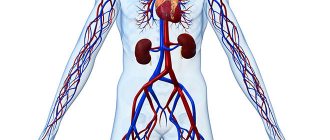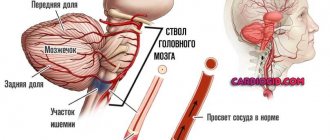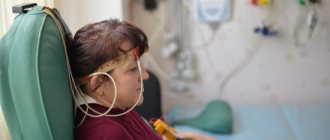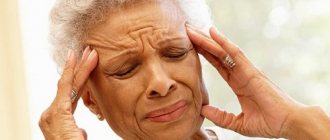Many people have experienced fainting. Sometimes they themselves experienced this phenomenon, sometimes someone around them did. It is precisely because of the prevalence and unexpectedness of this condition that it is important to know the main clinical signs of fainting. The ability to provide first aid in this situation can save a person’s life. The article discusses the most common signs of fainting and methods of dealing with it.
What is fainting?
This concept refers to a short-term loss of consciousness. The duration of this state ranges from a few seconds to ten minutes. The first option is most common.
Research has shown that in this way the brain tries to protect itself from hypoxia. Due to oxygen starvation, the body's defense system accelerates blood circulation, and the victim loses consciousness. Usually in this situation a person falls, and due to the body taking a horizontal position, it becomes easier for the heart to work (since the vessels are in a plane not directed upward). The volume of oxygen from such manipulations increases, and the symptoms of oxygen starvation disappear. It is after this that a person usually comes to his senses.
And although the duration of this phenomenon is relatively short, any complications cannot be ruled out. Therefore, if a person begins to faint (signs), it is better to provide assistance to him immediately.
Types of fainting
There is no generally accepted classification of fainting in medicine. One of the most rational, perhaps, is the following classification. So, fainting occurs:
- neurogenic;
- somatogenic;
- extreme;
- multifactorial.
CM. ALSO: Why do people faint?
Each of these groups is further subdivided into several varieties.
Neurogenic syncope
Neurogenic fainting is caused by any changes in the nervous system. Among them, the most famous are reflex ones (determined by the reflex activity of the nervous system). The mechanism for the occurrence of fainting in this group is as follows: as a result of irritation of certain receptors with the help of a reflex arc, the parasympathetic nervous system is activated and its sympathetic part is inhibited. As a result, peripheral vasodilation occurs and the heart rate slows, as well as a drop in total peripheral resistance, a drop in blood pressure and a decrease in cardiac output. As a result, blood is deposited in the muscles and is not delivered in the required quantity to the brain. This is the most common fainting of all varieties.
Irritation of which parts of the human body can cause fainting? It can be:
- irritation of the carotid sinus receptors (for example, when shaving, in the presence of a tumor formation in the carotid sinus area, compression of the neck with a tightly tied tie). The carotid sinus is located at the origin of the internal carotid artery from the common carotid artery in the neck at the level of the upper edge of the thyroid cartilage. These syncope are called sinocarotid syncope;
- sharp pain (for example, with a ruptured appendix or with renal colic), that is, irritation of pain receptors;
- coughing attack in older people (cough syncope, or bettolepsy). In older people, by a similar mechanism, fainting develops after eating or during bowel movements. The mechanism is to increase intrathoracic pressure during straining, thereby reducing cardiac output and the return of venous blood to the heart from the lower extremities;
- irritation of receptors of internal organs (irritative fainting). For example, when performing colonoscopy, esophagogastroduodenoscopy;
- irritation of the fibers of the vagus nerve (main parasympathetic nerve) when swallowing in certain diseases of the esophagus, larynx, and mediastinum;
- expressed emotions that become an irritating stimulus for the autonomic nervous system (in this case, the condition for the occurrence of fainting is the initial hyperreactivity of the autonomic nervous system, that is, with the normal tone of this system, fainting does not occur. Therefore, such fainting is more often the lot of people with neuroses, neurosis-like conditions, a tendency to hysteria). Fainting is called emotional. For example, the development of fainting when taking blood from suspicious people or when receiving extremely unpleasant news.
Neurogenic fainting also occurs:
- dyscirculatory (arise as a result of dysregulation of vascular tone in neurological diseases: migraine, dyscirculatory encephalopathy, cerebral vasculitis, and so on);
- maladaptive (develop as a result of disruption of the body’s adaptation mechanisms to unfavorable environmental conditions. For example, with overheating, heavy physical activity);
- associative (develop in situations that resemble past episodes with the development of fainting). Characteristic, so to speak, of creative people with a well-developed imagination;
- orthostatic (associated with insufficient sympathetic influence on the vessels of the lower extremities. In this case, when a person moves from a horizontal to a vertical position, proper constriction of the vessels of the lower extremities is not observed. Because of this, the increase in blood pressure necessary for the vertical position of the body does not develop, and therefore insufficient blood flows to the upper torso and head). Such fainting can occur when taking diuretics and antihypertensive drugs, blood loss, or dehydration.
Somatogenic syncope
These fainting spells are associated with diseases of other organs and systems (not the nervous system). They are usually divided into:
- cardiogenic (associated with heart disease). They occur as a result of a small ejection of blood from the left ventricle. This can happen with cardiac arrhythmias, with narrowing of the aorta as it exits the left ventricle, and so on;
- hypoglycemic (with a sharp decrease in blood glucose levels). Such fainting often accompanies diabetes mellitus, but can also occur in a number of other conditions: hypothalamic insufficiency, congenital fructose intolerance, fasting, benign and malignant tumors;
- anemic (for blood diseases with low levels of red blood cells and hemoglobin);
- respiratory (for lung diseases accompanied by a decrease in the vital capacity of the lungs, with a decrease in the concentration of carbon dioxide during hyperventilation. This is possible with bronchial asthma, emphysema, whooping cough).
Extreme fainting
Extreme fainting occurs in emergency situations that require maximum mobilization of forces from the body. They are divided into:
- hypovolemic (associated with severe fluid deficiency in the body, for example, due to blood loss or exposure to extreme heat);
- hypoxic (if there is little oxygen in the inhaled air, for example, when staying in the mountains);
- hyperbaric (breathing under high pressure);
- intoxication (the result of poisoning the body, for example, with alcohol, dyes or carbon monoxide);
- iatrogenic, or medicinal (in case of overdose of certain drugs: tranquilizers, antipsychotics, diuretics. In principle, this list can include any drugs that have the ability to lower blood pressure).
Multifactorial syncope
This group includes fainting, which occurs as a result of the coincidence of several causative factors. For example, the so-called nocturic syncope. It occurs predominantly in older men during or immediately after nighttime urination in an upright position. In this case, the following factors simultaneously influence: a decrease in pressure in the bladder leads to the dilation of blood vessels, which means the deposition of part of the blood in them; Plus, there is a sharp transition from a horizontal to a vertical position after sleep, and in sleep the influences of the parasympathetic part of the autonomic nervous system predominate. All this “robs” the brain, and fainting occurs.
CM. ALSO: Why do people faint?
The difference between fainting and loss of consciousness
These concepts are often used as synonyms, but there are still differences between them. Using the following formulations, you can determine the signs of fainting and manifestations of loss of consciousness:
- When you faint, overall muscle tone does not decrease. That is, a person does not go limp like a weak-willed doll. Loss of consciousness completely relaxes all the victim’s muscles.
- The body's protective reflexes do not weaken during fainting. While fainting, a person can breathe, but loss of consciousness can deprive him of this opportunity. In addition, in the latter case, tongue retraction is often observed, which, in turn, can lead to blockage of the airways and even death.
- A convulsive state may be a clear symptom of loss of consciousness. This action sends a signal to the brain about a serious threat to the body. Again, it must be taken into account that this option is also typical for epileptic attacks. But this is not typical for fainting.
Causes of loss of consciousness
Spontaneous loss of consciousness is divided into short-term and persistent. A brief loss of consciousness is often not dangerous. Characterized by a duration from a couple of seconds to two to three minutes. A brief loss of consciousness (fainting) does not have serious consequences and most often does not require medical intervention.
The described disorder is a concomitant symptom of the following ailments: epilepsy, concussion, hypoglycemia (temporary decrease in blood glucose), cerebral circulatory disorders, sudden changes in blood pressure.
Sustained loss of consciousness for the body comes with great serious consequences. Even if assistance and resuscitation procedures are provided in a timely manner, the condition in question poses a threat to the life and health of the individual. These include: extensive cerebral hemorrhage (stroke), cardiac arrest or disturbances, aneurysm rupture, various types of shock conditions, brain contusion, acute poisoning, internal bleeding and heavy blood loss, organ damage, various types of asphyxia; conditions caused by oxygen starvation; diabetic coma.
Associated negative factors and causes of short-term loss of consciousness are often due to physical indicators or the susceptibility of the human psyche to certain situations or events (bad news, unpleasant visual image). Changes in blood flow in the brain due to certain factors do not pose a particular threat. The most serious thing that happens is a fall and possible injury as a result. For example, during pregnancy, severe overwork, hunger, severe fear, unexpected joy, oxygen deficiency (overheating, stuffy room), severe intense pain, emotional stress.
Loss of consciousness caused by pathological changes requires medical attention and long-term treatment. It often occurs as a result of heart disease (ischemia, arrhythmia), post-traumatic condition, osteochondrosis of the cervical segment, convulsive attacks (epilepsy), diabetes (sharp increase or decrease in sugar), neoplasms, uncontrolled use of drugs aimed at reducing or increasing blood pressure.
Today, scientists have identified several reasons that increase the risk of loss of consciousness. Below are the main ones: a lack of blood supply to the brain, a lack of brain nutrition, decreased levels of oxygen in the blood, a malfunction, as a result of which uncharacteristic discharges appear in the brain area. The described disorders indicate the presence of temporary dysfunctions or indicate quite serious pathologies. The reasons discussed below are presented in more detail.
A deficiency in the blood supply to the brain can occur due to an excessively expressed function of the human ganglionic system. Often such a reaction occurs due to unusual situations or exposure to external stimuli. For example, in case of fear, due to various experiences, lack of oxygen.
Problems with the heart also often cause a lack of blood supply to the brain, causing fainting. This happens due to a decrease in blood emissions. Such cases often lead to a heart attack. Also, loss of consciousness and fainting can occur due to disruption of the heart rhythm. This problem is often caused by nerve impulses that accompany the atrium and ventricles.
Loss of consciousness is often caused by significant changes in the large capillaries supplying the brain. For example, with a disease such as atherosclerosis, a narrowing of the lumen of the vessel is observed, as a result of which the supply to various organs, including the brain, is disrupted.
Loss of consciousness can quite often occur due to the presence of blood clots, since there is a possibility of partial or complete closure of the vascular lumens by them, which will prevent the free flow of blood. Mostly blood clots occur due to surgery. Often blood clots clog capillaries after heart surgery, such as when replacing heart valves. To prevent serious consequences, people who are prone to increased blood clots are prescribed a number of blood thinning medications.
Dizziness and loss of consciousness are quite often caused by problems with blood pressure, which is kept at low levels for a long time. Subjects who abuse blood pressure medications and the elderly are also at risk.
A sudden movement of the body in space often also causes fainting. For example, a person can rise sharply, thereby changing the sitting position to a vertical one. During inactivity of the lower extremities, the functioning of the vessels is suspended, and they cannot quickly return to the desired shape if they suddenly assume a vertical position.
Various shock conditions often cause loss of consciousness, namely anaphylactic shock, which occurs as a result of a severe allergic reaction, infectious shock, which is a complication of serious illnesses.
Loss of consciousness due to oxygen deficiency in children or women occurs if the inhaled air does not contain the required amount of O2, so in stuffy spaces the risk of fainting increases.
In the pubertal stage of development, loss of consciousness can be triggered by various ailments that affect the lungs, for example, asthma. This problem especially affects people suffering from the chronic form of such ailments. A constant cough often causes various dysfunctions of the pulmonary system, as a result of which a significant oxygen deficiency occurs when inhaling.
Quite common causes of fainting are considered to be anemia and poisoning with oxygen oxide, which is a transparent gas that does not have a distinct smell or taste.
Loss of consciousness can also occur due to severe head injuries, stroke of any origin, or epilepsy.
Loss of consciousness for a few seconds can occur due to severe pain, due to severe fatigue, nervous strain, or constant lack of sleep. This phenomenon occurs as a result of expansion of muscle capillaries, a sharp drop in pressure, and blood outflow from the brain.
Fainting also develops when swallowing, at the time of urination or defecation. This type of short-term loss of consciousness can include a condition when an individual loses consciousness due to a tightly tightened tie or an excessively tight collar. Fainting often accompanies illnesses such as diabetes, amyloidosis, and alcoholism.
Weakness and loss of consciousness under certain circumstances are also observed in completely healthy individuals. For example, the consequence of fasting and strict diets is a deficiency of glucose in the brain, which triggers the metabolic process of starvation of the cortex. If you intensely physically load yourself on an empty stomach, then hungry fainting will be the result.
Overconsumption of simple carbohydrates can also lead to transient loss of consciousness. If the food consists exclusively of sweets washed down with tea and honey, then the pancreas will release insulin. Simple carbohydrates are quickly absorbed, as a result of which their content in the blood immediately after a meal is quite high. The amount of insulin produced in the blood will be equal to sugar levels. After the disposal of sugar in the blood, insulin will continue to work, while decomposing blood proteins. As a result, ketone bodies enter the blood vessels, causing metabolic disorders in the brain, which results in fainting.
Loss of consciousness for a few seconds can often occur due to a spasm of the cervical capillaries if you jump into ice water in extreme heat. In the blood of people, as a result of rising to a significant altitude, the partial pressure of O2 increases, as a result of which oxygen begins to be less utilized by the cells and oxygen starvation occurs, the outcome of which is loss of consciousness. Due to prolonged exposure to a steam room or sunstroke, you can also faint. Motion sickness in transport often provokes loss of consciousness. Less commonly, you may lose consciousness while performing weightlifting exercises or while playing a brass or woodwind instrument. In addition, loss of consciousness and vomiting occur in subjects when inhaling smoke or smoking a large amount, due to the onset of hypoxia and metabolic disorders.
The reasons for blackouts in the stronger half may differ significantly from the factors that cause syncope in women. Men may fall into an unconscious state more often due to alcohol poisoning, intense physical activity, or a tight shirt collar. In older representatives of the stronger half, fainting often occurs during nighttime urination.
Loss of consciousness and vomiting in the weaker half, in turn, is more often observed with internal blood loss caused by gynecological ailments, various pathologies of pregnancy, a powerful emotional outburst, or an overly strict diet.
Causes of fainting
The phenomena that provoked a fainting state usually include the following factors:
- Emotional shock, as well as the appearance of extremely severe pain. This also includes shock and fear. In such situations, there is a sharp drop in pressure, as a result of which blood flow deteriorates. Signs of fainting appear almost immediately.
- Weakening of the body, loss of strength. If a person is undernourished for a long time, lacks sleep and is very nervous, then he is at risk. The scheme of the situation is the same: the pressure drops, a faint state is observed.
- Staying for a long time in a room where there is smoke or simply little oxygen. If the air in a room is oversaturated with cigarette smoke, a person may faint due to severe oxygen deprivation.
- Prolonged stay in a standing position and without movement. It has been repeatedly noted that people who spend a long time in queues often faint. Due to the absence or insufficiency of motor activity, blood stagnates in the lower extremities, and this interferes with normal blood flow.
Treatment after fainting
Whether you need any treatment after fainting depends on the cause.
In case of reflex fainting, provoking factors should be avoided, since no treatment is required in this case. If you faint while your blood is being drawn, tell the nurse so they can have you lie down on the couch before pricking your finger or giving the injection. If you don't understand what exactly causes fainting, but your doctor says there is no threat to your health, you can keep a diary to determine the triggering factors.
In case of anemia, it is necessary to find out its cause and correct it: the range of conditions leading to anemia is very wide - from an unbalanced diet to a tumor.
If you have low blood pressure, it is recommended to avoid dehydration, not to eat large meals, and to drink caffeinated drinks. To prevent the pressure from dropping sharply, after you get up, you can resort to special maneuvers: cross your legs, tense the muscles in the lower part of your body, clench your fists or tense your arm muscles.
If fainting is caused by taking any medications, the doctor will stop or replace the culprit drug, change the dose or time of administration.
Some heart conditions will require surgery, including installation of a cardioverter-defibrillator (a device that monitors the heart's rhythm). In other cases, conservative therapy, for example, antiarrhythmic drugs, helps.
Types of fainting
Scientists have long identified an impressive number of types of short-term loss of consciousness. Among them:
- Orthostatic syncope. It usually occurs when there is a sudden change in body position - if you suddenly stand up from a lying position. There is dizziness and “wooliness” in the legs. This condition is dangerous with the risk of falling and injuring yourself.
- "High-altitude" fainting. This usually happens to a person at an unusual height, for example, when climbing a mountain.
- Convulsive. The name itself explains the whole meaning - signs of fainting are observed that are more characteristic of loss of consciousness: convulsions and change in complexion.
- Vasodepressor. Possible due to severe overexertion, stress and fatigue. A drop in pulse and blood pressure are signs of fainting in this case. To quickly get a person out of this state, you just need to lay him on a completely horizontal surface.
- Anemic fainting. When hemoglobin levels drop, a person is at risk. Elderly people are especially susceptible to this phenomenon.
- Fainting due to abnormal heart rhythms. In diseases of the cardiovascular system, this phenomenon is a frequent guest. The signs of cardiac syncope are the same as with normal syncope, the only difference is that the heart rate either drops greatly (less than 40 beats per minute) or increases greatly (more than 180-200 beats per minute).
There are other types and subtypes of short-term loss of consciousness, but they are less common.
What is fainting, why is it dangerous and what causes it - the main causes of fainting
A well-known phenomenon - fainting is a loss of consciousness for a very short period, from 5-10 seconds to 5-10 minutes. Fainting that lasts longer is already life-threatening.
Why is fainting dangerous?
Single episodes of fainting are not inherently life-threatening. But there are reasons for alarm if you faint...
- It is a manifestation of some dangerous disease (heart disease, heart attack, arrhythmia, etc.).
- Accompanied by head trauma.
- Occurs in a person whose activities are related to sports, driving a car, flying an aircraft, etc.
- Repeats from time to time or regularly.
- It happens in an elderly person - for no apparent reason and suddenly (there is a risk of complete heart block).
- Accompanied by the disappearance of all swallowing and breathing reflexes. There is a risk that the root of the tongue, due to relaxation of muscle tone, will sink and block the airways.
Fainting - as a reaction to the smell of paint or the sight of blood is not so dangerous (except for the risk of injury during a fall). It is much more dangerous if fainting is a symptom of an illness or nervous disorder. Don't delay visiting the doctor. The necessary specialists are a neurologist, cardiologist and psychiatrist.
There are many possible causes for fainting. The main, most common “triggers”:
- A short-term sharp decrease in pressure.
- Prolonged standing (especially if the knees are brought together, “at attention”).
- Staying in one position for a long time (sitting, lying down) and suddenly rising to your feet.
- Overheating, heat/sunstroke.
- Stuffiness, heat and even too bright light.
- State of hunger.
- Extreme fatigue.
- Fever.
- Emotional stress, mental shock, fear.
- Sharp, sudden pain.
- Severe allergic reaction (to medications, insect bites, etc.).
- Hypotension.
- Reaction to medications with high blood pressure.
- Arrhythmia, anemia or glycemia.
- Ear infection.
- Bronchial asthma.
- The onset of menstruation (in girls).
- Pregnancy.
- Disorders of the autonomic nervous system.
- A crowd, an impressive gathering of people.
- Features of puberty.
- Mental instability.
- Reducing blood sugar (with diabetes or a strict diet).
- Problems of cerebral circulation in old age.
- Nervous and physical exhaustion.
Types of fainting:
- Orthostatic syncope. It happens from a sudden change in body position (from horizontal to vertical). The cause may be insufficiency of the musculoskeletal system due to dysfunction of the nerve fibers involved in the vasomotor function. Fainting is dangerous due to falling and injury.
- Fainting caused by prolonged immobility (especially standing). Similar to the previous type. It occurs due to the lack of muscle contraction and adequate blood flow through the vessels in the legs (blood cannot overcome gravity and reach the brain).
- High altitude fainting. Occurs at high altitude due to poor blood supply to the brain.
- “Simple” fainting (without serious causes): clouding of consciousness, drop in pressure, intermittent breathing, short-term loss of consciousness, very rapid return to normal state.
- Convulsive fainting. The condition is accompanied by seizures and (often) redness/blueness of the face.
- Bettolepsy. Short-term fainting in chronic lung disease, occurring due to a strong coughing attack and the subsequent outflow of blood from the skull.
- Drop attacks. Dizziness, severe weakness and falling without loss of consciousness. Risk factors: pregnancy, cervical osteochondrosis.
- Vasodepressor syncope. It occurs due to stuffiness, lack of sleep, fatigue, emotional stress, fear, etc. The pulse drops below 60 beats/min, and blood pressure drops sharply. Fainting can often be prevented by simply sitting in a horizontal position.
- Arrhythmic syncope. A consequence of one type of arrhythmia.
- Situational fainting. Occurs after defecation, constipation, diving, heavy lifting, etc. due to increased intrathoracic pressure and other factors.
- Carotid sinus syndrome. Note that the carotid sinuses are extensions of the carotid arteries, the main suppliers of blood to the brain. Strong pressure on these sinuses (tight collar, sudden turn of the head) leads to fainting.
- Fainting in the presence of cardiac arrhythmias. Occurs with severe bradycardia (heart rate less than 40 beats/min) or with paroxysmal tachycardia (180-200 beats/min).
- Anemic fainting. Most often it occurs in older people due to a sharp decrease in hemoglobin, iron deficiency in the diet, or due to impaired iron absorption (when gastrointestinal diseases occur).
- Drug-induced syncope. Happens
- Occurs from drug intolerance/overdose.
Symptoms of fainting
A pre-fainting state is characterized by symptoms such as dizziness, severe weakness, nausea, icy sweat (usually felt in the back), tinnitus, blurred vision (up to the appearance of so-called “white noise” in front of the eyes), severe paleness and grayness of the skin.
Already in a faint, a person usually falls, the pupils stop responding to light sources, the pulse worsens or disappears altogether, and breathing becomes weak.
After fainting, the victim is still very weak and is not advised to try to get up for some time. This may cause another attack.
So, common signs of fainting are weakness and falling. If someone around you has fallen, and the symptoms of this situation resemble a short-term loss of consciousness, you need not to get lost, but immediately begin to act.
Symptoms of fainting
An attack of fainting is divided into several stages:
- presyncope, or lipothymia;
- actual fainting;
- post-fainting state.
The lipothymic state occurs immediately a few tens of seconds before loss of consciousness (most often it lasts from 4-20 seconds to 1-1.5 minutes). At this moment, a person feels a feeling of nausea (lightheadedness), dizziness, noise or ringing in the ears, blurred vision (“fog”, “veil”, “floaters before the eyes”). There is a growing weakness that rolls in like a wave. The legs become “wobbly” and unruly, the skin becomes covered with cold sweat, the face turns pale. In some patients, parallel to these symptoms, a feeling of anxiety or fear, palpitations, a feeling of lack of air or a lump in the throat, numbness of the fingertips, tongue, lips, and yawning appear. Sometimes this is the only thing that can limit an attack, that is, the loss of consciousness itself will not occur, especially if the patient manages to assume a horizontal position. In rare cases, syncope occurs without a previous lipothymic condition (eg, cardiac arrhythmias, syncope when swallowing). This stage ends with a feeling of “the ground floating away from under your feet.”
The stage of fainting itself is characterized by loss of consciousness. Simultaneously with the loss of consciousness, muscle tone throughout the body sharply weakens, so patients often seem to smoothly “slide” to the floor, rather than fall like tin soldiers. If fainting suddenly develops, bruises may occur if you fall. Typically, loss of consciousness lasts 5-60 seconds. During the absence of consciousness, the skin acquires a pale gray, ashy and even greenish color, becomes cold to the touch, blood pressure drops (systolic reading 60 mmHg and below), the pulse becomes weak, thread-like, breathing is shallow (it may even seem that the person is not breathing), all deep reflexes are reduced, the pupils dilate and react poorly to light (that is, they almost do not narrow, as is normal). If blood flow to the brain is not restored within 15-20 seconds, involuntary urination and defecation, as well as several muscle twitches, may occur.
The post-syncope period lasts only a few seconds until consciousness is fully restored. The restoration of consciousness occurs gradually: vision seems to turn on, the voices of others appear, initially sounding in the distance, the feeling of one’s own body returns. These sensations actually take a few seconds, but the patient himself remembers them as if they were in slow motion. After complete restoration of consciousness, patients immediately become oriented in place, time, and their own personality. Of course, the first reaction is fear at what happened. The heart rate and breathing increase, you feel tired and tired, sometimes unpleasant sensations in the abdomen and heart. The patient does not remember the second period of fainting, that is, the last memories are associated with a sudden deterioration in health.
The severity of fainting is determined by the duration of the period of loss of consciousness and the severity of disturbances in vital functions.
What should you do if a person faints?
First of all, you shouldn't panic. It is necessary to first free up more space around the victim and ensure a flow of fresh air. Then the task is to ensure a horizontal position, so that the head is lower than the entire body, and the legs are even higher. This is necessary for rapid blood flow to the brain.
Next, you should turn the person on his side so that if he vomits, he does not choke. After these manipulations, it is necessary to wipe the victim’s face with a wet napkin or let him smell a cotton wool soaked in ammonia. When the body temperature is low, the person should be covered with a warm blanket.
Fainting in a child
Many people experienced their first fainting spell in childhood.
Often in a child it is associated with strong emotions (fear, fear, strong excitement, stress), lack of sleep, overwork, hunger. Fainting can be caused by a stuffy room, overheating, or hypothermia. Dehydration, injury, acute and chronic diseases can also be a cause.
Fainting is characterized by certain symptoms. The child may complain of headache, dizziness, tinnitus, ringing, “flickers before the eyes,” and nausea. If fainting happens quickly, then he may not have time to tell about his poor health.
Then you should pay attention to the following signs in your child:
- skin becomes pale
- hands, feet are cold
- breathing is frequent, shallow
- cold sticky sweat appears
- he is inhibited, weakly reacts to sounds, touches
- his legs give way, he slips or falls to the floor
If fainting occurs at home, then parents need to do the following:
- Place the child on the bed, remove the pillow and elevate the legs using a bolster.
- Create an influx of fresh air by opening a window or window.
- Spray your face with cold water or place a wet towel on your forehead.
- Moisten a cotton swab with ammonia and let it smell.
- If the child does not regain consciousness within 3-5 minutes, call an ambulance immediately.
If a child has fainted for the first time and the reason is clear, then a trip to the doctor is not necessary. But if this is not the first time you have fainted, then it is better to consult a specialist for qualified help and diagnosis.
What should you not do with a fainting person?
First aid rules for fainting recommend placing the victim in a horizontal position, but it is important to remember that the head should still be slightly lower than the general level. Under no circumstances should you try to get a person to his feet. You can sit the victim down only if there is no way to put him on the floor or just on the ground. And even in this case, it is necessary to bend the victim’s head below the knees.
And of course, the main rule: if someone around you faints, you cannot be inactive. The risk of getting a concussion in the event of a short-term loss of consciousness is very high, and the lack of help in this case threatens the emergence of a variety of complications, in some cases leading to death.
Treatment
Fainting is one of the most common reasons people come to the emergency room. No wonder - sudden loss of consciousness can be quite alarming.
A hospital examination is useful and advisable. There you can find out whether there is a serious reason for fainting that needs to be treated.
What does the doctor do
The doctor's treatment depends on the cause of the fainting. The causes of momentary loss of consciousness should be checked with an emergency physician or emergency department.
Usually the doctor will already help the patient by conducting an interview to determine possible causes.
If a cardiac arrhythmia is suspected, a heart monitor monitors the activity of the heart over a period of time. If the suspicion is confirmed, the doctor will suggest suitable treatment if necessary.
For circulatory disorders (orthostatic syncope) in healthy people, no special therapy is required. If fainting occurs more frequently, your doctor may prescribe treatment.
How to prevent fainting?
To avoid such a dangerous condition, you need to eat right and lead a healthy lifestyle. It is the lack of control over nutrition and sleep, systematic overwork and stress that lead to fainting. As a means to combat stress, you can take a course of valerian or use any other sedative. Of course, you should visit your doctor before taking any medications.
You should stay in stuffy rooms as little as possible; if possible, you should give up bad habits. It is advisable to breathe fresh air more often, engage in feasible sports, or simply replace a trip on public transport with a walk. This is the only way to exclude yourself from the risk group.
When to call an ambulance if you faint
Dial 103 immediately if an unconscious person exhibits any of the following Fainting Treatment symptoms:
- fainting lasts longer than a minute;
- the victim has blue lips and face;
- it seems to you that the victim is not breathing and/or has a pulse;
- the person has regained consciousness, but complains of an irregular or too slow heartbeat;
- there are complaints of chest pain and difficulty breathing;
- after fainting, a person falls asleep, it is difficult to wake him up;
- during or after fainting, seizures, convulsions are observed, the person makes uncontrolled movements;
- the victim has regained consciousness, but complains of blurred vision, difficulty speaking, and confusion;
- a person was injured in a fall or you have reason to suspect it.
Do not under any circumstances hope that any of these signs will go away on their own. These symptoms indicate that the heart is not working properly. If help is not provided in time, the matter may end in death.
Diagnostics
Despite the fact that fainting often goes away on its own, diagnosis and treatment are necessary, because this condition is often a symptom of various diseases that may threaten a person’s health and life. In addition, it is not always clear why fainting occurs, and diagnostics will help determine the causes of the occurrence.
During a diagnostic examination, the doctor pays special attention to the following factors:
- patient's age;
- when and after what the first fainting occurred;
- frequency of subsequent attacks;
- signals that preceded the attack;
- activities that return the patient to consciousness.
People who were close to the person during the attack often provide valuable information.
It is very important to collect anamnesis, in particular information about the presence of chronic diseases (cardiovascular system, diabetes, etc.), as well as about the regular use of any medications.
- In this case, the first priority is to exclude urgent conditions that can manifest as fainting (PE, acute myocardial ischemia, bleeding, etc.).
- At the second stage, it is determined whether syncope is a manifestation of an organic brain disease (aneurysm of cerebral vessels, intracerebral tumor, etc.).
Among the laboratory methods that help in diagnosing the genesis of syncope are:
- general analysis of urine and blood,
- blood gas study,
- blood sugar determination,
- performing a glucose tolerance test,
- blood chemistry.
The examination plan for patients with syncope usually includes: ECG, EEG, REG, Echo-EG, USDG of extracranial vessels. If a cardiogenic nature of syncope is suspected, cardiac ultrasound, phonocardiography, 24-hour ECG monitoring, and stress tests are additionally prescribed. If organic brain damage is suspected, then MSCT or MRI of the brain, MRA, duplex scanning or transcranial ultrasound, and radiography of the spine in the cervical region are performed.











